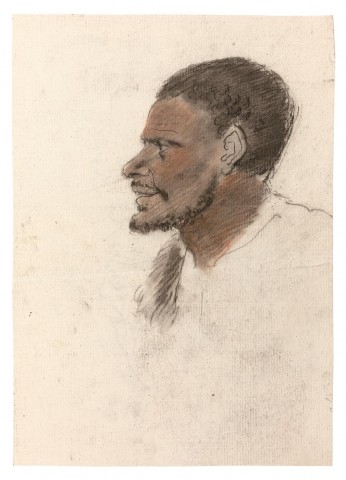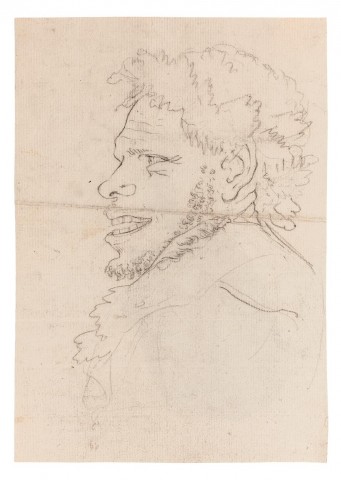RECTO: (PORTRAIT OF A MAN IN PROFILE, HEAD AND PARTIAL SHOULDERS), January or February 1802
NICOLAS-MARTIN PETIT
pastel on paper with watermark of crowned lion and sword with a pencil drawing of different man verso
270 x 191 mm (approx., irregular)
No full portrait, but feasibly related to the seated man figured in plate XV (1807)
Certainly B:20006, possibly B:20005
A wonderful profile portrait, the only known Tasmanian example of Petit working with coloured pastel: the artist has really captured the man, which is testament to his ability in the medium.
Given both the medium and the time constraints under which he was working this is an accomplished drawing, effortlessly capturing the man’s strong features, with a hint of a kangaroo-skin cloak draped over his right shoulder. He has a light beard and short hair, but not enough of his torso is shown to be confident about any scarification or other ornamentation.
One of the points, often stated, about the ways in which original works were converted into published engravings is that there was some inevitable distortion from the original. This sense of distortion and variation is particularly in play here, and yet it is clear that the present portrait is the original study for a gouache in Le Havre (B:20006), as is underscored by the great similarity in profile, the sparse beard and open mouth, the cropped but not fully shaven hair, and even the cloak over the shoulder.
It feels less immediately convincing, but the portrait does also bear a more than passing resemblance to another gouache (B:20005), showing a full-study of seated man at a fire (again, similar hair, nose, ears and beard, similar cloak over right shoulder, creased forehead, etc.). Significantly, assuming there is a connection between this simple profile in pastel and the fuller gouache, then it is clear that a version of this seated man was used in the composite plate XV.
Bonnemains does not list any other studies of any kind associated with this portrait, much as one might expect.
Because there is no specific engraving, and because neither this nor the associated portraits have any captioning, it is not possible to speculate about the precise locality in which this portrait was made; and therefore it is not possible to make any firm statement about its exact date of composition, beyond saying it is definitely from the period the French stayed in the region of Bruny Island—D’Entrecasteaux Channel—Maria Island.
It is tempting, nonetheless, to assume that this also dates from the same meetings and the same period as the following portraits simply because one of the men from the “Île Van Diemen” is drawn on the verso, implying that the sketches were done straight after each other.
A fine pencil sketch, clearly the original likeness that Petit then used to create his full portrait of a “Sauvage de l’île Van Diemen (Canal de d’Entrecasteaux)” (lot 6, following). The profile and general features of the man are unmistakable, as is the headband and elaborate cloak he is wearing; both of these would have been unusual in the French artist’s experience, given that the Tasmanian men were often said to be naked.
In terms of style and execution, the sketch can be compared with at least one other in Le Havre, an equally quick pencil portrait of a different man (B:20020).
The portrait and the likely time and place it was made are discussed more fully under lot 6 following, and in the introduction to the Tasmanian section on pp. 29-31.

